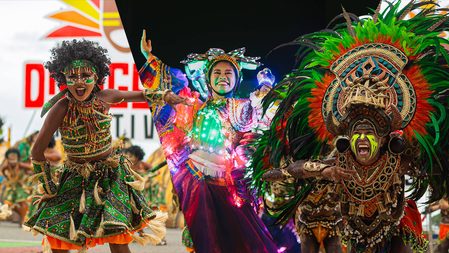SUMMARY
This is AI generated summarization, which may have errors. For context, always refer to the full article.
![[Ilonggo Notes] My Ati-Atihan and Dinagyang memories](https://www.rappler.com/tachyon/2023/02/dinagyang-1.jpg)
Iloilo City’s Dinagyang Festival returned on the fourth Sunday of January after a two-year hiatus (it went online because of the pandemic, and was voted the country’s top tourism event anyway by the Association of Tourism Officers of the Philippines).
For the past decades I’ve had ambivalent feelings towards the 55-year-old festival. Perhaps that comes from a surfeit of having seen so many similar costumes and choreographed moves throughout the years, the traffic jams it engenders when the performance areas are being set up, and the monotony of drumbeats that start off the practice sessions of the “tribes” commencing roughly in mid-October. The last time I saw the competitions was back in 2015, which coincided with a visit to Iloilo, and then I figured, seeing it once every 10 years suffices. Nonetheless, it has become a top crowd drawer, and somehow manages to live up to hype.

Dinagyang started as an offshoot of the more famed Kalibo Ati-Atihan. In 1968, a replica of the image of the Santo Niño de Cebu arrived in Iloilo, and was enshrined in the San Jose Placer Church run by the Augustinians. A solemn procession was organized around the plaza, and Ati-Atihan tribes from Aklan were invited. As in Kalibo, there was also a motley group of people who started dancing, mimicking the tribal rhythms with their own home-made, spontaneous “mixes” with school bands and drum and bugle corps, complimented by metal sticks banging on glass bottles.
Each year the “Iloilo Ati-Atihan,” as it was known then, grew. It was scheduled the weekend after the Kalibo festivities. In 1970, a tribe sponsored by the Compania Maritima, known as “Madjapahit,” won the initial competition. In 1974, the “Last Warriors” of Panaderia de Molo won the prestigious title, ending three years of domination by the “Ma-Mau” tribe sponsored by Negros Navigation. The Molo tribe innovatively used metal accessories, scrap parts from the iconic round biscuit cans, that jingled and tinkled, adding another dimension.
Being in Iloilo in the early ’80s meant that the festival was something to look forward to, and the religious origins were prominent – people danced and pledges (“panata”) were made to the child Jesus. In 1978, when the national government encouraged local festivals, the city chose the Iloilo Ati-Atihan. In a naming contest, “Dinagyang” won out, derived from “dagyang” (“merry-making”).

I was able to see the competitions up close from the early ’70s, as ROTC cadets were asked to form cordons and do crowd control. Major contenders such as Familia Sagasa, Himaya, Himala, and Atub-Atub developed their own distinctive drumbeat rhythm. Pedestrians would march and sway behind their favored groups, while others would make up their own beats and dance around to the boom-boom-BOOM! Boom-boom BOOM!, shouting “Hala Bira” “Pwera Pasma” (Give your all!/Illness be gone”), to which we’d add, “Sigue Dasok,” “Bisan Gutok” (Push it in/Even if tight), which refers to the crowds, with naughtier connotations.
People would sometimes brush your face with soot, a move described as “palhitanay,” similar to the drenching of people on the day of St, John the Baptist. One would be ill-advised to wear new or light-colored clothing. We would return from the merrymaking hoarse, tipsy, and drenched in sweat. One year, I saw my usually proper aunt, one of Iloilo’s best known businesswomen, still coiffed, in her orange pantsuit, doing the “sadsad” walk, to the beat of drums, just slightly tipsy, San Mig in hand.

Houses and shops lining the parade route would be packed. The Vidal house fronting St. Paul’s hospital would have one of their huge kapis shell windows, ventanillas open, allocated to our family as my mom and aunt were dear friends and colleagues of the owners, while others would be occupied by priests from the University of San Agustin and sisters from the Assumption convent. Merienda would be served. Reminiscing this now, it had this “tertulia-like” setting from a Nick Joaquin novel, albeit a more energetic one.
Once, the Binirayan festival tribe from Antique upended the best ones from Iloilo – with a secret weapon – all the troop members were female, they had mottled brown and gray as main colors, moved like graceful stalks being tossed about in the wind, the rustle of their costumes and their hissing sounds a complete contrast to the heart-pounding beats we were used to.
The rhythms of Kalibo
Undoubtedly the model for the Dinagyang is Kalibo’s Ati-atihan festival, which is centuries old. Felix Laureano, the first Filipino photographer, who in the 1890s had studios in Iloilo, Hong Kong, and Barcelona, was not impressed. In Recuerdos de Filipinas (1895), he has a photograph of an Ati group dancing, and writes: “to the monotonous pealing of the wooden Agung (a type of gong made from a hollowed out trunk), the Aetas carry out an unintelligible pantomime. Struck with a wood clapper, it produces sonorous, cacophonous vibrations that hurt the eardrums…at a command from their chief, armed with arrows and spears, they act out their own version of a war dance, changing places by the second, howling and shouting…they sing without intonation, harmony nor desire…their chants like the barks of dogs, and lasting for five to six hours…it lacks scenic interest, and has no appeal….”
He adds that the dances are similar to those performed by Igorots in the 1887 Madrid exposition. The descriptions leave no doubt that Laureano preferred jotas and rigodons. It is interesting to speculate how the war dances became devotions to the infant Jesus, then a caricature of the Ati ways (Ati-Atihan means “doing it like the Atis”) morphing into the spectacle that it is today. The term “cultural appropriation” comes to mind, and nowadays many of the Panay Bukidnon and Atis might be scratching their heads in puzzlement as marching bands, salsa-like moves, exotic costumes, and Broadway take over.
It’s been about 40 years since I last went to Kalibo for the Ati-Ati. Once, we stayed at the second floor of a funeral parlor, joking that if there were no beds available, the empty coffins downstairs would do just fine.
Comparisons between the two festivals are inevitable – one, “the original,” “you really feel the spirit;” the other “more showy, elaborate costumes, more of a spectacle.”
Dinagyang 2023
Being away for over 35 years, and eight years since my last Dinagyang, I was looking forward to things Ilonggo, and experiencing the Dinagyang Festival once more. I was offered a complimentary ticket for the performance, normally P3,000, but declined. Long lines to the grandstands, having longer waiting times than actual performances, people fawning over politicians and so-called celebrities, and being restricted to a chair for four hours was not appealing. I wanted to see the festival on foot again, wandering around the main heritage district of the city, with my trusty bicycle.
Back in the ’80s, with so many competing tribes, the parade seemed endless – in later years the tribes were screened and a separate parade, on Saturday – would be for the “Kasadyahan,” which accommodated other groups, while Sundays would be reserved for the centerpiece competition. This year, Kasadyahan had representation from outside of Iloilo — such as La Carlota (Negros), Culasi (Antique), etc. This adds additional fervor and flavor, as each group represents their own local shindigs. Prize money is offered, usually half of that of the Dinagyang pot.
This year, in addition to the Kasadyahan and the Dinagyang, there was an evening competition called “ILOmination.” Groups would have costumes and props that lit up. Three stages were set up along the malls in the newer city commercial areas. However, for someone watching streetside, without a ticket, it was not worth the long waiting time. It should be moved to the heritage district, and lighted parols of Pampanga would be a beautiful addition to the lighted floats.
“Parianon” tribe of Molo was the grand winner of Dinagyang 2023, bagging a P1 million prize. I didn’t see them perform live. They’d show their full repertoire at the Freedom grandstand, which had the largest performance area, and parts of their routines on the main streets along the four-kilometer parade route; no joke if you are blackened in soot and wearing an enormous headdress. A caravan of drummers, musicians, stage hands, and vehicles bearing wigs, costumes, props, and riser stages trails each group. It is a major production that entails months of preparation, often under wraps, lest others “steal” the ideas, the beats and the moves.

The side events and entrepreneurs
One other attraction of Dinagyang week are the many side events – the Opening Salvo, fluvial parade, processions, masses and novenas, bicycle races, sports events, art exhibits, food festivals, and others. Added treats this year were two free concerts by the Philippine Philharmonic Orchestra – both packed – and the opening of the Museum of National Maritime history. Economic benefits to the city and the various businesses are enormous. The performing tribes and their retinues keep thousands busy months before the festival. Visitors, in a festive mood, are happy to spend for accommodations, transport, food, drink, and pasalubong, adding significantly to the city’s coffers. Small entrepreneurs – street food and drinks vendors, face painters, and souvenir sellers do brisk business. Costumed warriors accept tips from those wishing to pose with them; also seen were horses with saddles, and exotic pets – iguanas and an albino Burmese python – for photo opportunities and a fee.
Weariness and wariness
One can easily rack up 20,000 steps a day during the weekend, since the city center and surrounding street blocks and bridges are off limits to vehicles. There are numerous options for food and coffee breaks in the downtown area. Several streets are allocated for pop-up food stalls; spots like Plaza Libertad and Muelle Loney had picnickers. I sneaked into the newly open Maritime History Museum with its grand neoclassic lobby, its air conditioners humming.
However, apprehension about the pandemic lingers, so I opted to wear a mask even in open streets, to reduce risks of transmission from any circulating viruses. One has to guard against possible pickpockets too. Finding space to park my bike was a breeze — I was the only one using the bike racks near the Drilon bridge, which is perfect for a take-off and venture into the downtown area a block away. Bag and security checks were done at various entry points. The old city center became walkable again, even just for a few hours that weekend.
The jamming of cell phone signals at certain hours made it feel like a throwback to the 20th century – people talking to each other, only whipping phones out to take photos. That decision was later flayed on social media, as other areas well outside the city centers were inconvenienced because of the block.
Families with young children were a pleasant sight, many had painted faces, clearly enjoying the perfect weather that day. And this year, also impressive was the way the streets were cleared up after the festival. With the stages and overdue parols now dismantled, Iloilo takes a breather – until the next Dinagyang. – Rappler.com
Vic Salas is a physician and public health specialist by training, and now retired from international consulting work. He is back in Iloilo City, where he spent his first quarter century.
Add a comment
How does this make you feel?






There are no comments yet. Add your comment to start the conversation.